Evolution of Flood Prediction and Forecasting Models for Flood Early Warning Systems: A Scoping Review
Abstract
:1. Introduction
- To examine the most advanced methods/technologies for flood forecasting in the context of FEWSs,
- To provide an overview of the chronological evolution of flood forecasting in the context of FEWSs between 1993–2023,
- To provide an overview of flood forecasting models for data-scarce regions to help in model selection for FEWSs in such areas.
2. Materials and Methods
- The generation of the main keywords to be used in database search,
- Choosing the relevant databases, as well as structuring the querying process,
- Screening and sorting the relevant quality documents for analysis and,
- Processing the results into understandable information for reporting.
3. Results
4. Discussion
4.1. Overview of Flood Early Warning Systems (FEWSs) in the Context of Information Systems
4.2. Flood Monitoring and Forecasting in FEWSs
4.3. Flood Forecasting Models in FEWSs
4.3.1. Deterministic Models
4.3.2. Data-Driven Models
4.3.3. Chronological Evolution of Flood Forecasting Models in FEWSs
4.3.4. Ensemble Predictions
4.4. Flood Forecasting in Data Scarce Regions
4.4.1. Challenges of Data-Scarce Regions and FEWSs
4.4.2. Solutions of Data-Scarce Regions and FEWSs
4.5. Challenges and Opportunities
5. Conclusions
Author Contributions
Funding
Acknowledgments
Conflicts of Interest
References
- Perera, D.; Seidou, O.; Agnihotri, J.; Rasmy, M.; Smakhtin, V.; Coulibaly, P.; Mehmood, H. Flood Early Warning Systems: A Review of Benefits, Challenges and Prospects; UNU-INWEH: Hamilton, ON, Canada, 2019. [Google Scholar]
- EM-DAT. Inventorying Hazards & Disasters Worldwide. 2023. Available online: https://www.emdat.be (accessed on 24 December 2023).
- Milly, P.C.D.; Wetherald, R.T.; Dunne, K.; Delworth, T.L. Increasing risk of great floods in a changing climate. Nature 2002, 415, 514–517. [Google Scholar] [CrossRef] [PubMed]
- Hirabayashi, Y.; Mahendran, R.; Koirala, S.; Konoshima, L.; Yamazaki, D.; Watanabe, S.; Kim, H.; Kanae, S. Global flood risk under climate change. Nat. Clim. Chang. 2013, 3, 816–821. [Google Scholar] [CrossRef]
- Ali, H.; Modi, P.; Mishra, V. Increased flood risk in Indian sub-continent under the warming climate. Weather Clim. Extrem. 2019, 25, 100212. [Google Scholar] [CrossRef]
- Najibi, N.; Devineni, N. Recent trends in the frequency and duration of global floods. Earth Syst. Dyn. 2018, 9, 757–783. [Google Scholar] [CrossRef]
- Lee, H.-C.; Chen, H. Implementing the Sendai Framework for disaster risk reduction 2015–2030: Disaster governance strategies for persons with disabilities in Taiwan. Int. J. Disaster Risk Reduct. 2019, 41, 101284. [Google Scholar] [CrossRef]
- Nhamo, L.; Matchaya, G.; Mabhaudhi, T.; Nhlengethwa, S.; Nhemachena, C.; Mpandeli, S. Cereal production trends under climate change: Impacts and adaptation strategies in southern Africa. Agriculture 2019, 9, 30. [Google Scholar] [CrossRef]
- Scholes, R.; Engelbrecht, F. Climate impacts in southern Africa during the 21st Century. In Report for Earthjustice and the Centre for Envrionmental Rights; Global Change Instiute, University of Witwatersrand: Johannesburg, South Africa, 2021. [Google Scholar]
- Bedeke, S.B. Climate change vulnerability and adaptation of crop producers in sub-Saharan Africa: A review on concepts, approaches and methods. Environ. Dev. Sustain. 2023, 25, 1017–1051. [Google Scholar] [CrossRef]
- Bouchard, J.-P.; Pretorius, T.B.; Kramers-Olen, A.L.; Padmanabhanunni, A.; Stiegler, N. Global warming and psychotraumatology of natural disasters: The case of the deadly rains and floods of April 2022 in South Africa. Ann. Médico-Psychol. Rev. Psychiatr. 2023, 181, 234–239. [Google Scholar] [CrossRef]
- Busayo, E.T.; Kalumba, A.M.; Afuye, G.A.; Olusola, A.O.; Ololade, O.O.; Orimoloye, I.R. Rediscovering South Africa: Flood disaster risk management through ecosystem-based adaptation. Environ. Sustain. Indic. 2022, 14, 100175. [Google Scholar] [CrossRef]
- Madzivhandila, T.S.; Maserumule, M.H. The Irony of a “Fire Fighting” Approach towards Natural Hazards in South Africa: Lessons from Flooding Disaster in KwaZulu-Natal; South African Association of Public Administration and Management (SAAPAM): Soshanguve, South Africa, 2022; Volume 57, pp. 191–194. [Google Scholar]
- Gleick, P.H. Global freshwater resources: Soft-path solutions for the 21st century. Science 2003, 302, 1524–1528. [Google Scholar] [CrossRef]
- Brandes, O.; Brooks, D.B.; Gurman, S. Making the Most of the Water We Have: The Soft Path Approach to Water Management; Routledge: London, UK, 2009. [Google Scholar]
- Jamasy, O.; Siagian, E.; Movianto, G.E.; Pranoto, Y.; Nisa, K. Impact Analysis of Structural and Non-Structural Program and Collaboration of Stakeholder to Productivity of Sustainable Flood Mitigation Management. Int. J. Soc. Sci. Res. Rev. 2023, 6, 698–709. [Google Scholar]
- Yildirim, E.; Alabbad, Y.; Demir, I. Non-structural Flood Mitigation Optimization at Community Scale: Middle Cedar Case Study. J. Environ. Manag. 2023, 346, 119025. [Google Scholar] [CrossRef] [PubMed]
- Hapuarachchi, H.; Wang, Q.; Pagano, T. A review of advances in flash flood forecasting. Hydrol. Process. 2011, 25, 2771–2784. [Google Scholar] [CrossRef]
- Jain, S.K.; Mani, P.; Jain, S.K.; Prakash, P.; Singh, V.P.; Tullos, D.; Kumar, S.; Agarwal, S.; Dimri, A. A Brief review of flood forecasting techniques and their applications. Int. J. River Basin Manag. 2018, 16, 329–344. [Google Scholar] [CrossRef]
- Mosavi, A.; Ozturk, P.; Chau, K.-W. Flood prediction using machine learning models: Literature review. Water 2018, 10, 1536. [Google Scholar] [CrossRef]
- Aljohani, F.H.; Alkhodre, A.B.; Sen, A.A.A.; Ramazan, M.S.; Alzahrani, B.; Siddiqui, M.S. Flood Prediction using Hydrologic and ML-based Modeling: A Systematic Review. Int. J. Adv. Comput. Sci. Appl. 2023, 14, 538. [Google Scholar] [CrossRef]
- Antwi-Agyakwa, K.T.; Afenyo, M.K.; Angnuureng, D.B. Know to predict, forecast to warn: A review of flood risk prediction tools. Water 2023, 15, 427. [Google Scholar] [CrossRef]
- Diaconu, D.C.; Costache, R.; Popa, M.C. An overview of flood risk analysis methods. Water 2021, 13, 474. [Google Scholar] [CrossRef]
- Munawar, H.S.; Hammad, A.W.; Waller, S.T. Remote sensing methods for flood prediction: A review. Sensors 2022, 22, 960. [Google Scholar] [CrossRef]
- Sheikh, M.R.; Coulibaly, P. Review of Recent Developments in Hydrologic Forecast Merging Techniques. Water 2024, 16, 301. [Google Scholar] [CrossRef]
- Moher, D.; Liberati, A.; Tetzlaff, J.; Altman, D.G.; PRISMA Group. Preferred reporting items for systematic reviews and meta-analyses: The PRISMA statement. Ann. Intern. Med. 2009, 151, 264–269. [Google Scholar] [CrossRef] [PubMed]
- Pulwarty, R.S.; Sivakumar, M.V. Information systems in a changing climate: Early warnings and drought risk management. Weather Clim. Extrem. 2014, 3, 14–21. [Google Scholar] [CrossRef]
- Molinari, D.; Menoni, S.; Ballio, F. Flood Early Warning Systems: Knowledge and Tools for Their Critical Assessment; Wit Press: Southampton, UK, 2013. [Google Scholar]
- Sukhwani, V.; Gyamfi, B.A.; Zhang, R.; AlHinai, A.M.; Shaw, R. Understanding the barriers restraining effective operation of flood early warning systems. Int. J. Disaster Risk Manag. 2019, 1, 1–19. [Google Scholar] [CrossRef]
- Bajracharya, S.R.; Khanal, N.R.; Nepal, P.; Rai, S.K.; Ghimire, P.K.; Pradhan, N.S. Community assessment of flood risks and early warning system in Ratu Watershed, Koshi Basin, Nepal. Sustainability 2021, 13, 3577. [Google Scholar] [CrossRef]
- Perera, D.; Seidou, O.; Agnihotri, J.; Mehmood, H.; Rasmy, M. Challenges and technical advances in flood early warning systems (FEWSs). In Flood Impact Mitigation and Resilience Enhancement; IntechOpen: London, UK, 2020. [Google Scholar]
- Osman, S.; Aziz, N.A.; Husaif, N.; Sidek, L.M.; Shakirah, A.; Hanum, F.; Basri, H. Application of stochastic flood forecasting model using regression method for Kelantan catchment. In Proceedings of the International Conference on Civil, Offshore & Environmental Engineering 2018 (ICCOEE 2018), Kuala Lumpur, Malaysia, 13–14 August 2018; p. 07001. [Google Scholar]
- Kumar, V.; Azamathulla, H.M.; Sharma, K.V.; Mehta, D.J.; Maharaj, K.T. The state of the art in deep learning applications, challenges, and future prospects: A comprehensive review of flood forecasting and management. Sustainability 2023, 15, 10543. [Google Scholar] [CrossRef]
- Yang, C.; Yu, M.; Hu, F.; Jiang, Y.; Li, Y. Utilizing cloud computing to address big geospatial data challenges. Comput. Environ. Urban Syst. 2017, 61, 120–128. [Google Scholar] [CrossRef]
- WMO. Manual on Flood Forecasting and Warning; World Meteorological Organization: Geneva, Switzerland, 2011; p. 1072. [Google Scholar]
- Lavers, D.A.; Ramos, M.-H.; Magnusson, L.; Pechlivanidis, I.; Klein, B.; Prudhomme, C.; Arnal, L.; Crochemore, L.; Van Den Hurk, B.; Weerts, A.H. A vision for hydrological prediction. Atmosphere 2020, 11, 237. [Google Scholar] [CrossRef]
- Kauffeldt, A.; Wetterhall, F.; Pappenberger, F.; Salamon, P.; Thielen, J. Technical review of large-scale hydrological models for implementation in operational flood forecasting schemes on continental level. Environ. Model. Softw. 2016, 75, 68–76. [Google Scholar] [CrossRef]
- Okiria, E.; Okazawa, H.; Noda, K.; Kobayashi, Y.; Suzuki, S.; Yamazaki, Y. A Comparative Evaluation of Lumped and Semi-Distributed Conceptual Hydrological Models: Does Model Complexity Enhance Hydrograph Prediction? Hydrology 2022, 9, 89. [Google Scholar] [CrossRef]
- WMO. Mission Report, WMO Fact-Finding and Needs-Assessment Mission to Pakistan. 2000. Available online: https://www.wmo.int/pages/prog/dra/rap/documents/PakistanMissionReport.pdf (accessed on 12 December 2023).
- Sidle, R.C. Strategies for smarter catchment hydrology models: Incorporating scaling and better process representation. Geosci. Lett. 2021, 8, 24. [Google Scholar] [CrossRef]
- Singh, A. A concise review on introduction to hydrological models. Glob. Res. Dev. J. Eng. 2018, 3, 14–19. [Google Scholar]
- Girihagama, L.; Naveed Khaliq, M.; Lamontagne, P.; Perdikaris, J.; Roy, R.; Sushama, L.; Elshorbagy, A. Streamflow modelling and forecasting for Canadian watersheds using LSTM networks with attention mechanism. Neural Comput. Appl. 2022, 34, 19995–20015. [Google Scholar] [CrossRef]
- Liu, K.; Li, Z.; Yao, C.; Chen, J.; Zhang, K.; Saifullah, M. Coupling the k-nearest neighbor procedure with the Kalman filter for real-time updating of the hydraulic model in flood forecasting. Int. J. Sediment Res. 2016, 31, 149–158. [Google Scholar] [CrossRef]
- Liu, Z.; Guo, S.; Zhang, H.; Liu, D.; Yang, G. Comparative Study of Three Updating Procedures for Real-Time Flood Forecasting. Water Resour. Manag. 2016, 30, 2111–2126. [Google Scholar] [CrossRef]
- Grini, N.; Montanari, A. Real Time Flood Forecasting for the Reno River (Italy) through the TOPKAPI Rainfall-Runoff Model. Master’s Thesis, Università di Bologna, Bologna, Italy, 2018. [Google Scholar]
- Rana, S.K.; Rana, H.K.; Luo, D.; Sun, H. Estimating climate-induced ‘Nowhere to go’range shifts of the Himalayan Incarvillea Juss. using multi-model median ensemble species distribution models. Ecol. Indic. 2021, 121, 107127. [Google Scholar] [CrossRef]
- Lee, G.; Kim, W.; Oh, H.; Youn, B.D.; Kim, N.H. Review of statistical model calibration and validation—From the perspective of uncertainty structures. Struct. Multidiscip. Optim. 2019, 60, 1619–1644. [Google Scholar] [CrossRef]
- Merz, R.; Blöschl, G. A process typology of regional floods. Water Resour. Res. 2003, 39. [Google Scholar] [CrossRef]
- Vogel, E.; Lerat, J.; Pipunic, R.; Frost, A.; Donnelly, C.; Griffiths, M.; Hudson, D.; Loh, S. Seasonal ensemble forecasts for soil moisture, evapotranspiration and runoff across Australia. J. Hydrol. 2021, 601, 126620. [Google Scholar] [CrossRef]
- Moradkhani, H.; Sorooshian, S. General Review of Rainfall-Runoff Modeling: Model Calibration, Data Assimilation, and Uncertainty Analysis; Springer: Berlin/Heidelberg, Germany, 2008. [Google Scholar]
- Liu, Y.; Zhang, K.; Li, Z.; Liu, Z.; Wang, J.; Huang, P. A hybrid runoff generation modelling framework based on spatial combination of three runoff generation schemes for semi-humid and semi-arid watersheds. J. Hydrol. 2020, 590, 125440. [Google Scholar] [CrossRef]
- Karki, M.; Khadka, D.B. Simulation of Rainfall-Runoff of Kankai River Basin Using SWAT Model: A Case Study of Nepal. Int J Res. Appl. Sci. Eng. Technol. 2020, 8, 308–326. [Google Scholar] [CrossRef]
- Bharat, S.; Mishra, V. Runoff sensitivity of Indian sub-continental river basins. Sci. Total Environ. 2021, 766, 142642. [Google Scholar] [CrossRef] [PubMed]
- Yin, H.; Guo, Z.; Zhang, X.; Chen, J.; Zhang, Y. RR-Former: Rainfall-runoff modeling based on Transformer. J. Hydrol. 2022, 609, 127781. [Google Scholar] [CrossRef]
- Ahrens, S.R. Flood forecasting for the Buffalo Bayou using CRWR-PrePro and HEC-HMS. Tech. Rep. Univ. Tex. Austin Cent. Res. Water Resour. 1999, 1999, ii-139. [Google Scholar]
- Oleyiblo, J.O.; Li, Z.J. Application of HEC-HMS for flood forecasting in Misai and Wan’an catchments in China. Water Sci. Eng. 2010, 3, 14–22. [Google Scholar] [CrossRef]
- Haile, A.T.; Tefera, F.T.; Rientjes, T. Flood forecasting in Niger-Benue basin using satellite and quantitative precipitation forecast data. Int. J. Appl. Earth Obs. Geoinf. 2016, 52, 475–484. [Google Scholar] [CrossRef]
- Ali, S.; Cheema, M.J.M.; Bakhsh, A.; Khaliq, T. Near real time flood forecasting in the transboundary chenab river using global satellite mapping of precipitation. Pak. J. Agric. Sci. 2020, 57, 1327–1335. [Google Scholar] [CrossRef]
- Agarwal, A.; Ghimire, U.; Than, H.H.; Srinivasan, G.; Dash, I.; Shakya, N.; Oo, M.T. Operationalizing a flood forecasting decision support system for Ayeyarwady river, Myanmar. Int. J. River Basin Manag. 2021, 19, 509–522. [Google Scholar] [CrossRef]
- Chowdhury, M.E.; Islam, A.S.; Lemans, M.; Hegnauer, M.; Sajib, A.R.; Pieu, N.M.; Das, M.K.; Shadia, N.; Haque, A.; Roy, B.; et al. An efficient flash flood forecasting system for the un-gaged Meghna basin using open source platform Delft-FEWS: Flash Flood Forecasting System using Delft-FEWS Platform. Environ. Model. Softw. 2023, 161, 105614. [Google Scholar] [CrossRef]
- Sahu, S.; Pyasi, S.; Galkate, R. A review on the HEC-HMS rainfall-runoff simulation model. Int. J. Agric. Sci. Res. 2020, 10, 183–190. [Google Scholar]
- Martin, O.; Rugumayo, A.; Ovcharovichova, J. Application of HEC HMS/RAS and GIS tools in flood modeling: A case study for river Sironko–Uganda. Glob. J. Eng. Des Technol. 2012, 1, 19–31. [Google Scholar]
- Thakur, B.; Parajuli, R.; Kalra, A.; Ahmad, S.; Gupta, R. Coupling HEC-RAS and HEC-HMS in precipitation runoff modelling and evaluating flood plain inundation map. In Proceedings of the World Environmental and Water Resources Congress 2017, Sacramento, CA, USA, 21–25 May 2017; pp. 240–251. [Google Scholar]
- Abdessamed, D.; Abderrazak, B. Coupling HEC-RAS and HEC-HMS in rainfall–runoff modeling and evaluating floodplain inundation maps in arid environments: Case study of Ain Sefra city, Ksour Mountain. SW of Algeria. Environ. Earth Sci. 2019, 78, 586. [Google Scholar] [CrossRef]
- Meresa, H. Modelling of river flow in ungauged catchment using remote sensing data: Application of the empirical (SCS-CN), artificial neural network (ANN) and hydrological model (HEC-HMS). Model. Earth Syst. Environ. 2019, 5, 257–273. [Google Scholar] [CrossRef]
- Gholami, V.; Khaleghi, M.R. A simulation of the rainfall-runoff process using artificial neural network and HEC-HMS model in forest lands. J. For. Sci. 2021, 67, 165–174. [Google Scholar] [CrossRef]
- Naresh, A.; Naik, M.G. Urban Rainfall-Runoff Modeling Using HEC-HMS and Artificial Neural Networks: A Case Study. Int. J. Math. Eng. Manag. Sci. 2023, 8, 403–423. [Google Scholar] [CrossRef]
- Kumar, V.; Sharma, K.V.; Caloiero, T.; Mehta, D.J.; Singh, K. Comprehensive overview of flood modeling approaches: A review of recent advances. Hydrology 2023, 10, 141. [Google Scholar] [CrossRef]
- Sadeghi, F.; Rubinato, M.; Goerke, M.; Hart, J. Assessing the performance of LISFLOOD-FP and SWMM for a small watershed with scarce data availability. Water 2022, 14, 748. [Google Scholar] [CrossRef]
- Rajib, A.; Liu, Z.; Merwade, V.; Tavakoly, A.A.; Follum, M.L. Towards a large-scale locally relevant flood inundation modeling framework using SWAT and LISFLOOD-FP. J. Hydrol. 2020, 581, 124406. [Google Scholar] [CrossRef]
- Peng, T.; Qi, H.; Wang, J. Case Study on Extreme Flood Forecasting Based on Ensemble Precipitation Forecast in Qingjiang Basin of the Yangtze River. J. Coast. Res. 2020, 104, 178–187. [Google Scholar] [CrossRef]
- Jiang, F.; Dong, Z.; Wang, Z.; Zhu, Y.; Liu, M.; Luo, Y.; Zhang, T. Flood forecasting using an improved narx network based on wavelet analysis coupled with uncertainty analysis by monte carlo simulations: A case study of taihu basin, china. J. Water Clim. Chang. 2021, 12, 2674–2696. [Google Scholar] [CrossRef]
- Gong, J.; Yao, C.; Li, Z.; Chen, Y.; Huang, Y.; Tong, B. Improving the flood forecasting capability of the Xinanjiang model for small-and medium-sized ungauged catchments in South China. Nat. Hazards 2021, 106, 2077–2109. [Google Scholar] [CrossRef]
- Jiang, X.; Zhang, L.; Liang, Z.; Fu, X.; Wang, J.; Xu, J.; Zhang, Y.; Zhong, Q. Study of early flood warning based on postprocessed predicted precipitation and Xinanjiang model. Weather Clim. Extrem. 2023, 42, 100611. [Google Scholar] [CrossRef]
- Cui, Z.; Zhou, Y.; Guo, S.; Wang, J.; Ba, H.; He, S. A novel hybrid XAJ-LSTM model for multi-step-ahead flood forecasting. Hydrol. Res. 2021, 52, 1436–1454. [Google Scholar] [CrossRef]
- Tang, Y.; Sun, Y.; Han, Z.; Soomro, S.E.E.; Wu, Q.; Tan, B.; Hu, C. flood forecasting based on machine learning pattern recognition and dynamic migration of parameters. J. Hydrol. Reg. Stud. 2023, 47, 101406. [Google Scholar] [CrossRef]
- Coccia, G.; Ceresa, P.; Bussi, G.; Denaro, S.; Bazzurro, P.; Martina, M.; Fagà, E.; Avelar, C.; Ordaz, M.; Huerta, B. Large-scale flood risk assessment in data scarce areas: An application to Central Asia. Nat. Hazards Earth Syst. Sci. Discuss. 2023, 2023, 1–33. [Google Scholar]
- Rabba, Z.A. Flood frequency analysis with PyTOPKAPI model-simulated stream flows from Aweitu river in Jimma town, Ethiopia. Sustain. Water Resour. Manag. 2023, 9, 46. [Google Scholar] [CrossRef]
- Luchetta, A.; Manetti, S. A real time hydrological forecasting system using a fuzzy clustering approach. Comput. Geosci. 2003, 29, 1111–1117. [Google Scholar] [CrossRef]
- Guo, Z.; Leitão, J.P.; Simões, N.E.; Moosavi, V. Data-driven flood emulation: Speeding up urban flood predictions by deep convolutional neural networks. J. Flood Risk Manag. 2021, 14, e12684. [Google Scholar] [CrossRef]
- Box, G.E.; Jenkins, G.M.; Reinsel, G.C.; Ljung, G.M. Time Series Analysis: Forecasting and Control; John Wiley & Sons: Hoboken, NJ, USA, 2015. [Google Scholar]
- Kumar, S.; Kumar, R.; Chakravorty, B.; Chatterjee, C.; Pandey, N.G. An artificial neural network approach for flood forecasting. J. Inst. Eng. (India) Part CP Comput. Eng. Div. 2003, 84, 52–55. [Google Scholar]
- Govindaraju, R.S. Artificial neural networks in hydrology. I: Preliminary concepts. J. Hydrol. Eng. 2000, 5, 115–123. [Google Scholar]
- Wang, Z.-Y.; Qiu, J.; Li, F.-F. Hybrid models combining EMD/EEMD and ARIMA for Long-term streamflow forecasting. Water 2018, 10, 853. [Google Scholar] [CrossRef]
- Celikyilmaz, A.; Turksen, I.B. Modeling uncertainty with fuzzy logic. Stud. Fuzziness Soft Comput. 2009, 240, 149–215. [Google Scholar]
- Chen, C.S.; Jhong, Y.D.; Wu, W.Z.; Chen, S.T. Fuzzy time series for real-time flood forecasting. Stoch. Environ. Res. Risk Assess. 2019, 33, 645–656. [Google Scholar] [CrossRef]
- Janál, P.; Kozel, T. Fuzzy logic based flash flood forecast. In Electronic Book with Full Papers from XXVIII Conference of the Danubian Countries on Hydrological Forecasting and Hydrological Bases of Water Management: November 6–8, 2019, Kyiv, Ukraine; Ukrainian Hydrometeorological Institute: Kyiv, Ukraine, 2019; p. 86. [Google Scholar]
- Hakim, S.; Razak, H.A. Adaptive neuro fuzzy inference system (ANFIS) and artificial neural networks (ANNs) for structural damage identification. Struct. Eng. Mech. 2013, 45, 779–802. [Google Scholar] [CrossRef]
- Cunge, J.A. Of data and models. J. Hydroinformatics 2003, 5, 75–98. [Google Scholar] [CrossRef]
- Zhang, Y.; He, J.; Yang, C.; Xie, J.; Fitzmorris, R.; Wen, X.-H. A physics-based data-driven model for history matching, prediction, and characterization of unconventional reservoirs. SPE J. 2018, 23, 1105–1125. [Google Scholar] [CrossRef]
- Yao, S.; Kan, G.; Liu, C.; Tang, J.; Cheng, D.; Guo, J.; Jiang, H. A Hybrid Theory-Driven and Data-Driven Modeling Method for Solving the Shallow Water Equations. Water 2023, 15, 3140. [Google Scholar] [CrossRef]
- Qin, W.; Wang, L.; Lin, A.; Zhang, M.; Xia, X.; Hu, B.; Niu, Z. Comparison of deterministic and data-driven models for solar radiation estimation in China. Renew. Sustain. Energy Rev. 2018, 81, 579–594. [Google Scholar] [CrossRef]
- Hiroi, K.; Kawaguchi, N. FloodEye: Real-time flash flood prediction system for urban complex water flow. In Proceedings of the 2016 IEEE SENSORS, Orlando, FL, USA, 30 October–3 November 2016; pp. 1–3. [Google Scholar]
- Tsakiri, K.; Marsellos, A.; Kapetanakis, S. Artificial neural network and multiple linear regression for flood prediction in Mohawk River, New York. Water 2018, 10, 1158. [Google Scholar] [CrossRef]
- Ghorpade, P.; Gadge, A.; Lende, A.; Chordiya, H.; Gosavi, G.; Mishra, A.; Hooli, B.; Ingle, Y.S.; Shaikh, N. Flood forecasting using machine learning: A review. In Proceedings of the 2021 8th International Conference on Smart Computing and Communications (ICSCC), Kochi, Kerala, India, 1–3 July 2021; pp. 32–36. [Google Scholar]
- Tiwari, M.K.; Deo, R.C.; Adamowski, J.F. Short-term flood forecasting using artificial neural networks, extreme learning machines, and M5 model tree. In Advances in Streamflow Forecasting: From Traditional to Modern Approaches; Elsevier: Amsterdam, The Netherlands, 2021; pp. 263–279. [Google Scholar] [CrossRef]
- El-Magd, S.A.A.; Pradhan, B.; Alamri, A. Machine learning algorithm for flash flood prediction mapping in Wadi El-Laqeita and surroundings, Central Eastern Desert, Egypt. Arab. J. Geosci. 2021, 14, 323. [Google Scholar] [CrossRef]
- Brath, A.; Montanari, A.; Toth, E. Neural networks and non-parametric methods for improving realtime flood forecasting through conceptual hydrological models. Hydrol. Earth Syst. Sci. 2002, 6, 627–640. [Google Scholar] [CrossRef]
- Wang, J.; Shi, P.; Jiang, P.; Hu, J.; Qu, S.; Chen, X.; Chen, Y.; Dai, Y.; Xiao, Z. Application of BP neural network algorithm in traditional hydrological model for flood forecasting. Water 2017, 9, 48. [Google Scholar] [CrossRef]
- Ali, M.H.M.; Asmai, S.A.; Abidin, Z.Z.; Abas, Z.A.; Emran, N.A. Flood Prediction using Deep Learning Models. Int. J. Adv. Comput. Sci. Appl. 2022, 13. [Google Scholar] [CrossRef]
- Kaur, M.; Kaur, P.D.; Sood, S.K. Energy efficient IoT-based cloud framework for early flood prediction. Nat. Hazards 2021, 109, 2053–2076. [Google Scholar] [CrossRef]
- Sylvia, J.M.A.; Rani, M.P.; Aremu, B. Analysis of IoT big weather data for early flood forecasting system. In Proceedings of the 2021 Fourth International Conference on Electrical, Computer and Communication Technologies (ICECCT), Erode, India, 15–17 September 2021; IEEE: Piscataway, NJ, USA; pp. 1–6. [Google Scholar] [CrossRef]
- Bhaskar, G.; Vedashree, C.N.; Astha, R.; Bharath, T.R.; Sudha, G.T. Flood Prediction and Alert System using ML and Sensor Networks. Grenze Int. J. Eng. Technol. (GIJET) 2022, 8, 373. [Google Scholar]
- Brito, L.A.; Meneguette, R.I.; De Grande, R.E.; Ranieri, C.M.; Ueyama, J. FLORAS: Urban flash-flood prediction using a multivariate model. Appl. Intell. 2023, 53, 16107–16125. [Google Scholar] [CrossRef]
- Thankappan, J.; Mary, D.R.K.; Yoon, D.J.; Park, S.H. Adaptive Momentum-Backpropagation Algorithm for Flood Prediction and Management in the Internet of Things. Comput. Mater. Contin. 2023, 77, 1053–1079. [Google Scholar] [CrossRef]
- Chang, F.-J.; Chen, Y.-C.; Liang, J.-M. Fuzzy clustering neural network as flood forecasting model. Hydrol. Res. 2002, 33, 275–290. [Google Scholar] [CrossRef]
- Corani, G.; Guariso, G. An application of pruning in the design of neural networks for real time flood forecasting. Neural Comput. Appl. 2005, 14, 66–77. [Google Scholar] [CrossRef]
- Ren, M.; Wang, B.; Liang, Q.; Fu, G. Classified real-time flood forecasting by coupling fuzzy clustering and neural network. Int. J. Sediment Res. 2010, 25, 134–148. [Google Scholar] [CrossRef]
- Seo, Y.; Kim, S.; Singh, V.P. Multistep-ahead flood forecasting using wavelet and data-driven methods. KSCE J. Civ. Eng. 2015, 19, 401–417. [Google Scholar] [CrossRef]
- Indra, G.; Duraipandian, N. Modeling of Optimal Deep Learning Based Flood Forecasting Model Using Twitter Data. Intell. Autom. Soft Comput. 2023, 35, 1455–1470. [Google Scholar] [CrossRef]
- Kang, M.G.; Park, S.W.; Cai, X. Integration of hydrologic gray model with global search method for real-time flood forecasting. J. Hydrol. Eng. 2009, 14, 1136–1145. [Google Scholar] [CrossRef]
- Chang, F.J.; Liang, J.M.; Chen, Y.C. Flood forecasting using radial basis function neural networks. IEEE Trans. Syst. Man Cybern. Part C Appl. Rev. 2001, 31, 530–535. [Google Scholar] [CrossRef]
- Ruslan, F.A.; Zain, Z.M.; Adnan, R. Modelling flood prediction using Radial Basis Function Neural Network (RBFNN) and Inverse Model: A Comparative Study. In Proceedings of the 2013 IEEE International Conference on Control System, Computing and Engineering, Penang, Malaysia, 29 November–14 December 2013; pp. 577–581. [Google Scholar]
- Panigrahi, B.K.; Nath, T.K.; Senapati, M.R. An application of local linear radial basis function neural network for flood prediction. J. Manag. Anal. 2019, 6, 67–87. [Google Scholar] [CrossRef]
- Wardah, T.; Abu Bakar, S.H.; Bardossy, A.; Maznorizan, M. Use of geostationary meteorological satellite images in convective rain estimation for flash-flood forecasting. J. Hydrol. 2008, 356, 283–298. [Google Scholar] [CrossRef]
- Yang, C.C.; Chen, C.S. Application of integrated back-propagation network and self organizing map for flood forecasting. Hydrol. Process. Int. J. 2009, 23, 1313–1323. [Google Scholar] [CrossRef]
- Hu, R.; Fang, F.; Pain, C.C.; Navon, I.M. Rapid spatio-temporal flood prediction and uncertainty quantification using a deep learning method. J. Hydrol. 2019, 575, 911–920. [Google Scholar] [CrossRef]
- Lee, J.H.; Yuk, G.M.; Moon, H.T.; Moon, Y.I. Integrated flood forecasting and warning system against flash rainfall in the small-scaled urban stream. Atmosphere 2020, 11, 971. [Google Scholar] [CrossRef]
- Sarker, C.; Mejias, L.; Maire, F.; Woodley, A. Flood mapping with convolutional neural networks using spatio-contextual pixel information. Remote Sens. 2019, 11, 2331. [Google Scholar] [CrossRef]
- Khosravi, K.; Panahi, M.; Golkarian, A.; Keesstra, S.D.; Saco, P.M.; Bui, D.T.; Lee, S. Convolutional neural network approach for spatial prediction of flood hazard at national scale of Iran. J. Hydrol. 2020, 591, 125552. [Google Scholar] [CrossRef]
- Chen, C.; Jiang, J.; Liao, Z.; Zhou, Y.; Wang, H.; Pei, Q. A short-term flood prediction based on spatial deep learning network: A case study for Xi County, China. J. Hydrol. 2022, 607, 127535. [Google Scholar] [CrossRef]
- Wu, J.; Liu, H.; Wei, G.; Song, T.; Zhang, C.; Zhou, H. Flash flood forecasting using support vector regression model in a small mountainous catchment. Water 2019, 11, 1327. [Google Scholar] [CrossRef]
- Shada, B.; Chithra, N.; Thampi, S.G. Hourly flood forecasting using hybrid wavelet-SVM. J. Soft Comput. Civ. Eng. 2022, 6, 1–20. [Google Scholar]
- Yaseen, M.W.; Awais, M.; Riaz, K.; Rasheed, M.B.; Waqar, M.; Rasheed, S. Artificial Intelligence Based Flood Forecasting for River Hunza at Danyor Station in Pakistan. Arch. Hydroeng. Environ. Mech. 2022, 69, 59–77. [Google Scholar] [CrossRef]
- Zalnezhad, A.; Rahman, A.; Nasiri, N.; Vafakhah, M.; Samali, B.; Ahamed, F. Comparing performance of ANN and SVM methods for regional flood frequency analysis in South-East Australia. Water 2022, 14, 3323. [Google Scholar] [CrossRef]
- Kurniyaningrum, E.; Limantara, L.M.; Suhartanto, E.; Sisinggih, D. Development of flood early warning system based on the geoinformatics system in the Krukut River, Jakarta, Indonesia. Int. J. Civ. Eng. Technol. 2019, 10, 1325–1335. [Google Scholar]
- Tabbussum, R.; Dar, A.Q. Modelling hybrid and backpropagation adaptive neuro-fuzzy inference systems for flood forecasting. Nat. Hazards 2021, 108, 519–566. [Google Scholar] [CrossRef]
- Manocha, A.; Sood, S.K.; Bhatia, M. Digital Twin-assisted Fuzzy Logic-inspired Intelligent Approach for Flood Prediction. IEEE Sens. J. 2023. [Google Scholar] [CrossRef]
- Hellmann, M. Fuzzy Logic Introduction; Université de Rennes: Rennes, France, 2001; p. 1. [Google Scholar]
- Tareghian, R.; Kashefipour, S.M. Application of fuzzy systems and artificial neural networks for flood forecasting. J. Appl. Sci. 2007, 7, 3451–3459. [Google Scholar] [CrossRef]
- Hadi, M.; Yakub, F.; Fakhrurradzi, A.; Hui, C.; Najiha, A.; Fakharulrazi, N.; Harun, A.; Rahim, Z.; Azizan, A. Designing early warning flood detection and monitoring system via IoT. In IOP Conference Series: Earth and Environmental Science; IOP Publishing: Bristol, UK, 2020; p. 012016. [Google Scholar]
- Jamali, A.; Giman, J.P. Performance Analysis of IOT based Flood Monitoring Framework in Sub-urban. In Proceedings of the 2021 IEEE 7th International Conference on Smart Instrumentation, Measurement and Applications (ICSIMA), Bandung, Indonesia, 23–25 August 2021; pp. 99–104. [Google Scholar]
- Nahar, H.; Bahaman, N.; Shah, W.M.; Abdul-Aziz, A.; Khalid, A.M.; Hassan, A.; Ahmad, M.R. Real-time Monitoring IoT-based System for Early Flash Flood Notification in Melaka. Multidiscip. Appl. Res. Innov. 2022, 3, 29–36. [Google Scholar]
- Zakaria, M.I.; Jabbar, W.A.; Sulaiman, N. Development of a smart sensing unit for LoRaWAN-based IoT flood monitoring and warning system in catchment areas. Internet Things Cyber-Phys. Syst. 2023, 3, 249–261. [Google Scholar] [CrossRef]
- Al Qundus, J.; Dabbour, K.; Gupta, S.; Meissonier, R.; Paschke, A. Wireless sensor network for AI-based flood disaster detection. Ann. Oper. Res. 2022, 319, 697–719. [Google Scholar] [CrossRef]
- Huang, R.; Ma, L.; Zhai, G.; He, J.; Chu, X.; Yan, H. Resilient routing mechanism for wireless sensor networks with deep learning link reliability prediction. IEEE Access 2020, 8, 64857–64872. [Google Scholar] [CrossRef]
- Khalaf, M.; Alaskar, H.; Hussain, A.J.; Baker, T.; Maamar, Z.; Buyya, R.; Liatsis, P.; Khan, W.; Tawfik, H.; Al-Jumeily, D. IoT-enabled flood severity prediction via ensemble machine learning models. IEEE Access 2020, 8, 70375–70386. [Google Scholar] [CrossRef]
- Anbarasan, M.; Muthu, B.; Sivaparthipan, C.; Sundarasekar, R.; Kadry, S.; Krishnamoorthy, S.; Dasel, A.A. Detection of flood disaster system based on IoT, big data and convolutional deep neural network. Comput. Commun. 2020, 150, 150–157. [Google Scholar] [CrossRef]
- Weigel, A.P.; Liniger, M.; Appenzeller, C. Can multi-model combination really enhance the prediction skill of probabilistic ensemble forecasts? Q. J. R. Meteorol. Soc. A J. Atmos. Sci. Appl. Meteorol. Phys. Oceanogr. 2008, 134, 241–260. [Google Scholar] [CrossRef]
- Leutbecher, M.; Palmer, T.N. Ensemble forecasting. J. Comput. Phys. 2008, 227, 3515–3539. [Google Scholar] [CrossRef]
- Ibrahim, K.S.M.H.; Huang, Y.F.; Ahmed, A.N.; Koo, C.H.; El-Shafie, A. A review of the hybrid artificial intelligence and optimization modelling of hydrological streamflow forecasting. Alex. Eng. J. 2022, 61, 279–303. [Google Scholar] [CrossRef]
- Khaki, M.; Ait-El-Fquih, B.; Hoteit, I. Calibrating land hydrological models and enhancing their forecasting skills using an ensemble Kalman filter with one-step-ahead smoothing. J. Hydrol. 2020, 584, 124708. [Google Scholar] [CrossRef]
- Yang, Y.; Guo, H.; Jin, Y.; Song, A. An ensemble prediction system based on artificial neural networks and deep learning methods for deterministic and probabilistic carbon price forecasting. Front. Environ. Sci. 2021, 9, 740093. [Google Scholar] [CrossRef]
- Brown, J.D.; Wu, L.; He, M.; Regonda, S.; Lee, H.; Seo, D.-J. Verification of temperature, precipitation, and streamflow forecasts from the NOAA/NWS Hydrologic Ensemble Forecast Service (HEFS): 1. Experimental design and forcing verification. J. Hydrol. 2014, 519, 2869–2889. [Google Scholar] [CrossRef]
- Artigue, G.; Johannet, A.; Borrell, V.; Pistre, S. Flash flood forecasting in poorly gauged basins using neural networks: Case study of the Gardon de Mialet basin (southern France). Nat. Hazards Earth Syst. Sci. 2012, 12, 3307–3324. [Google Scholar] [CrossRef]
- Ishitsuka, Y.; Gleason, C.J.; Hagemann, M.W.; Beighley, E.; Allen, G.H.; Feng, D.; Lin, P.; Pan, M.; Andreadis, K.; Pavelsky, T.M. Combining optical remote sensing, McFLI discharge estimation, global hydrologic modeling, and data assimilation to improve daily discharge estimates across an entire large watershed. Water Resour. Res. 2021, 57, e2020WR027794. [Google Scholar] [CrossRef]
- Sutcliffe, J.; Knott, D. Historical variations in African water resources. Influ. Clim. Chang. Clim. Var. Hydrol. Regime Water Resour. 1987, 168, 463–476. [Google Scholar]
- Nicholson, S.E.; Klotter, D.; Dezfuli, A.K. Spatial reconstruction of semi-quantitative precipitation fields over Africa during the nineteenth century from documentary evidence and gauge data. Quat. Res. 2012, 78, 13–23. [Google Scholar] [CrossRef]
- Sunilkumar, K.; Narayana Rao, T.; Satheeshkumar, S. Assessment of small-scale variability of rainfall and multi-satellite precipitation estimates using measurements from a dense rain gauge network in Southeast India. Hydrol. Earth Syst. Sci. 2016, 20, 1719–1735. [Google Scholar] [CrossRef]
- Wang, K.; Guan, Q.; Chen, N.; Tong, D.; Hu, C.; Peng, Y.; Dong, X.; Yang, C. Optimizing the configuration of precipitation stations in a space-ground integrated sensor network based on spatial-temporal coverage maximization. J. Hydrol. 2017, 548, 625–640. [Google Scholar] [CrossRef]
- Hughes, D. Comparison of satellite rainfall data with observations from gauging station networks. J. Hydrol. 2006, 327, 399–410. [Google Scholar] [CrossRef]
- Loukas, A.; Quick, M.C. Comparison of six extreme flood estimation techniques for ungauged watersheds in coastal British Columbia. Can. Water Resour. J. 1995, 20, 17–30. [Google Scholar] [CrossRef]
- Kjeldsen, T.R.; Smithers, J.; Schulze, R. Flood frequency analysis at ungauged sites in the KwaZulu-Natal Province, South Africa. Water SA 2001, 27, 315–324. [Google Scholar] [CrossRef]
- Grover, P.L.; Burn, D.H.; Cunderlik, J.M. A comparison of index flood estimation procedures for ungauged catchments. Can. J. Civ. Eng. 2002, 29, 734–741. [Google Scholar] [CrossRef]
- Kjeldsen, T.R.; Smithers, J.; Schulze, R. Regional flood frequency analysis in the KwaZulu-Natal province, South Africa, using the index-flood method. J. Hydrol. 2002, 255, 194–211. [Google Scholar] [CrossRef]
- Lawal, D.U.; Yusof, K.W.; Hashim, M.A.; Balogun, A.-L. Spatial analytic hierarchy process model for flood forecasting: An integrated approach. Proceedings of IOP Conference Series: Earth and Environmental Science; IOP Publishing: Bristol, UK, 2014; p. 012029. [Google Scholar]
- Mohammadifar, A.; Gholami, H.; Golzari, S. Novel integrated modelling based on multiplicative long short-term memory (mLSTM) deep learning model and ensemble multi-criteria decision making (MCDM) models for mapping flood risk. J. Environ. Manag. 2023, 345, 118838. [Google Scholar] [CrossRef] [PubMed]
- Ayoubi Ayoublu, S.; Vafakhah, M.; Pourghasemi, H. Flood risk assessment using Multi-Criteria Decision-Making Models (MCDM) and data mining methods (case study: Shiraz District 4). JWSS-Isfahan Univ. Technol. 2022, 26, 247–265. [Google Scholar]
- Chakraborty, S.; Chatterjee, P.; Das, P.P. Evaluation Based on Distance from Average Solution (Edas) Method. In Multi-Criteria Decision-Making Methods in Manufacturing Environments; Apple Academic Press: Point Pleasant, NJ, USA, 2024; pp. 183–189. [Google Scholar]
- Kasiviswanathan, K.S.; He, J.; Tay, J.-H. Flood frequency analysis using multi-objective optimization based interval estimation approach. J. Hydrol. 2017, 545, 251–262. [Google Scholar] [CrossRef]
- Yuan, F.; Zhang, L.; Soe, K.M.W.; Ren, L.; Zhao, C.; Zhu, Y.; Jiang, S.; Liu, Y. Applications of TRMM-and GPM-era multiple-satellite precipitation products for flood simulations at sub-daily scales in a sparsely gauged watershed in Myanmar. Remote Sens. 2019, 11, 140. [Google Scholar] [CrossRef]
- Harris, A.; Rahman, S.; Hossain, F.; Yarborough, L.; Bagtzoglou, A.C.; Easson, G. Satellite-based flood modeling using TRMM-based rainfall products. Sensors 2007, 7, 3416–3427. [Google Scholar] [CrossRef] [PubMed]
- Kachi, M. Overview of Global Satellite Mapping of Precipitation (GSMaP). In Proceedings of the 6th World Water Forum, March, Marseille, France, 12–17 March 2012. [Google Scholar]
- Chao, L.; Zhang, K.; Yang, Z.-L.; Wang, J.; Lin, P.; Liang, J.; Li, Z.; Gu, Z. Improving flood simulation capability of the WRF-Hydro-RAPID model using a multi-source precipitation merging method. J. Hydrol. 2021, 592, 125814. [Google Scholar] [CrossRef]
- Wahyuni, S.; Sisinggih, D.; Dewi, I. Validation of climate hazard group infrared precipitation with station (CHIRPS) data in wonorejo reservoir, Indonesia. In IOP Conference Series: Earth and Environmental Science; IOP Publishing: Bristol, UK, 2021; p. 012042. [Google Scholar]
- Alijanian, M.; Rakhshandehroo, G.R.; Mishra, A.; Dehghani, M. Evaluation of remotely sensed precipitation estimates using PERSIANN-CDR and MSWEP for spatio-temporal drought assessment over Iran. J. Hydrol. 2019, 579, 124189. [Google Scholar] [CrossRef]
- Collischonn, B.; Collischonn, W.; Tucci, C.E.M. Daily hydrological modeling in the Amazon basin using TRMM rainfall estimates. J. Hydrol. 2008, 360, 207–216. [Google Scholar] [CrossRef]
- Maggioni, V.; Massari, C. On the performance of satellite precipitation products in riverine flood modeling: A review. J. Hydrol. 2018, 558, 214–224. [Google Scholar] [CrossRef]
- Masood, M.; Naveed, M.; Iqbal, M.; Nabi, G.; Kashif, H.M.; Jawad, M.; Mujtaba, A. Evaluation of Satellite Precipitation Products for Estimation of Floods in Data-Scarce Environment. Adv. Meteorol. 2023, 2023. [Google Scholar] [CrossRef]
- Yeditha, P.K.; Kasi, V.; Rathinasamy, M.; Agarwal, A. Forecasting of extreme flood events using different satellite precipitation products and wavelet-based machine learning methods. Chaos Interdiscip. J. Nonlinear Sci. 2020, 30, 063115. [Google Scholar] [CrossRef] [PubMed]
- Kumar, A.; Singh, V. Real-time flood forecasting using satellite precipitation product and machine learning approach in Bagmati river basin, India. Acta Geophys. 2024, 1–21. [Google Scholar] [CrossRef]
- Piotrowski, A.P.; Napiorkowski, J.J. A comparison of methods to avoid overfitting in neural networks training in the case of catchment runoff modelling. J. Hydrol. 2013, 476, 97–111. [Google Scholar] [CrossRef]
- Oruche, R.; Egede, L.; Baker, T.; O’Donncha, F. Transfer learning to improve streamflow forecasts in data sparse regions. arXiv 2021, arXiv:2112.03088. [Google Scholar]
- Chancay, J.E.; Espitia-Sarmiento, E.F. Improving hourly precipitation estimates for flash flood modeling in data-scarce andean-amazon basins: An integrative framework based on machine learning and multiple remotely sensed data. Remote Sens. 2021, 13, 4446. [Google Scholar] [CrossRef]
- Sampurno, J.; Vallaeys, V.; Ardianto, R.; Hanert, E. Integrated hydrodynamic and machine learning models for compound flooding prediction in a data-scarce estuarine delta. Nonlinear Process. Geophys. 2022, 29, 301–315. [Google Scholar] [CrossRef]
- Lee, H.; Li, W. Improving interpretability of deep active learning for flood inundation mapping through class ambiguity indices using multi-spectral satellite imagery. Remote Sens. Environ. 2024, 309, 114213. [Google Scholar] [CrossRef]
- Kazadi, A.N.; Doss-Gollin, J.; Sebastian, A.; Silva, A. Flood prediction with graph neural networks. Climate Change AI. Climate Change AI 2022. [Google Scholar]
- Mahesh, R.B.; Leandro, J.; Lin, Q. Physics informed neural network for spatial-temporal flood forecasting. In Climate Change and Water Security: Select Proceedings of VCDRR 2021; Springer: Berlin/Heidelberg, Germany, 2022; pp. 77–91. [Google Scholar]
- Goodarzi, L.; Banihabib, M.E.; Roozbahani, A.; Dietrich, J. Bayesian network model for flood forecasting based on atmospheric ensemble forecasts. Nat. Hazards Earth Syst. Sci. 2019, 19, 2513–2524. [Google Scholar] [CrossRef]
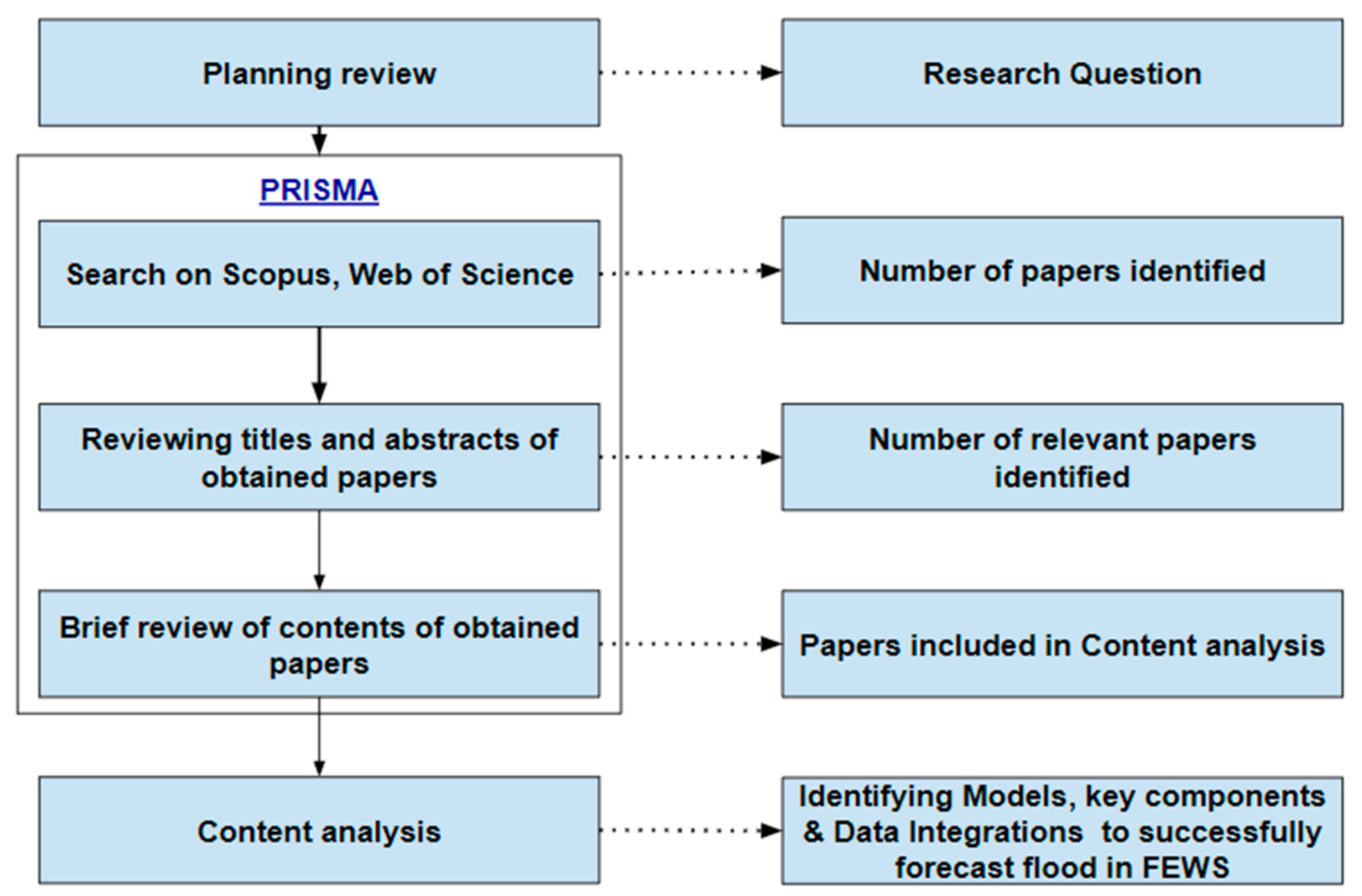

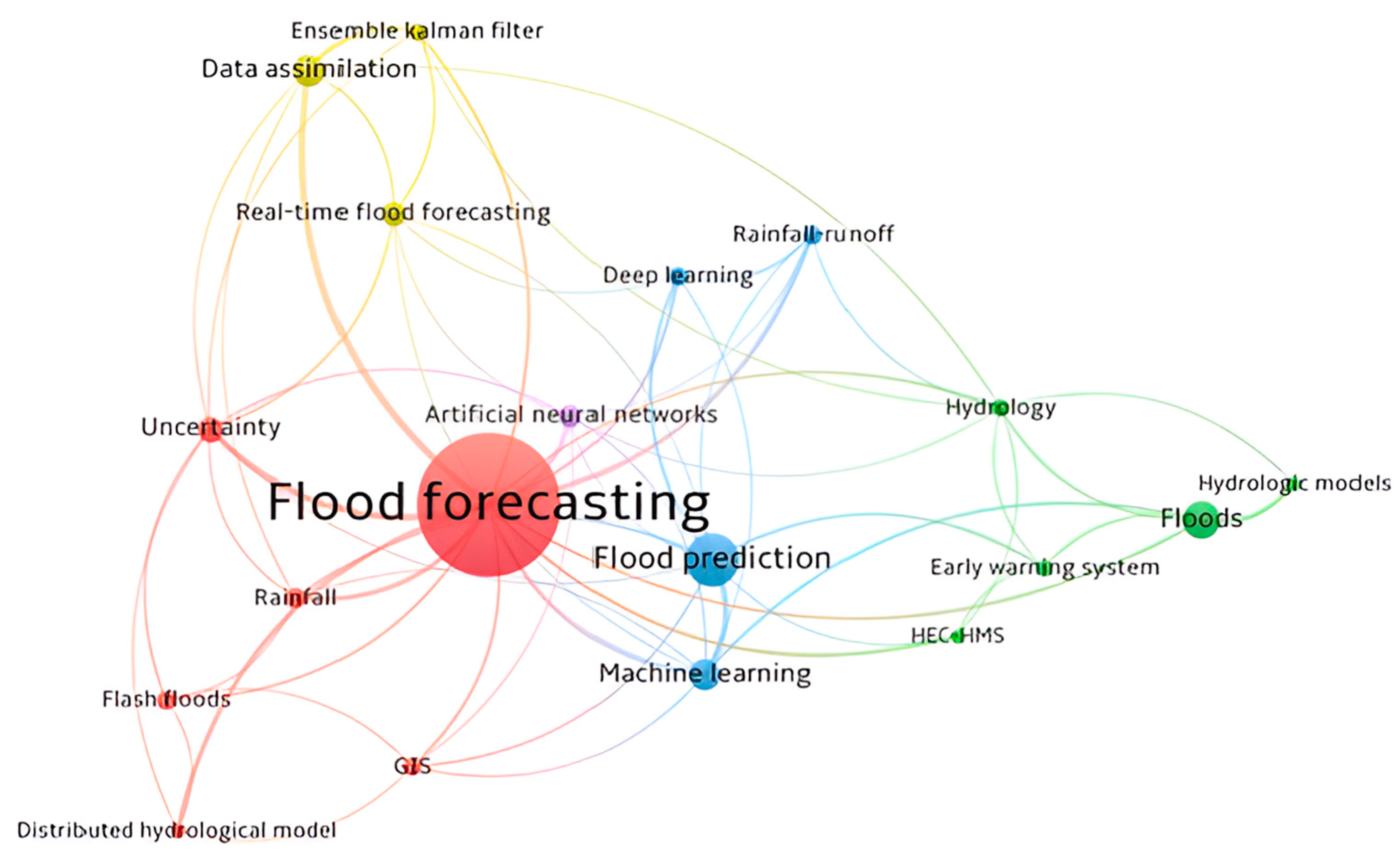
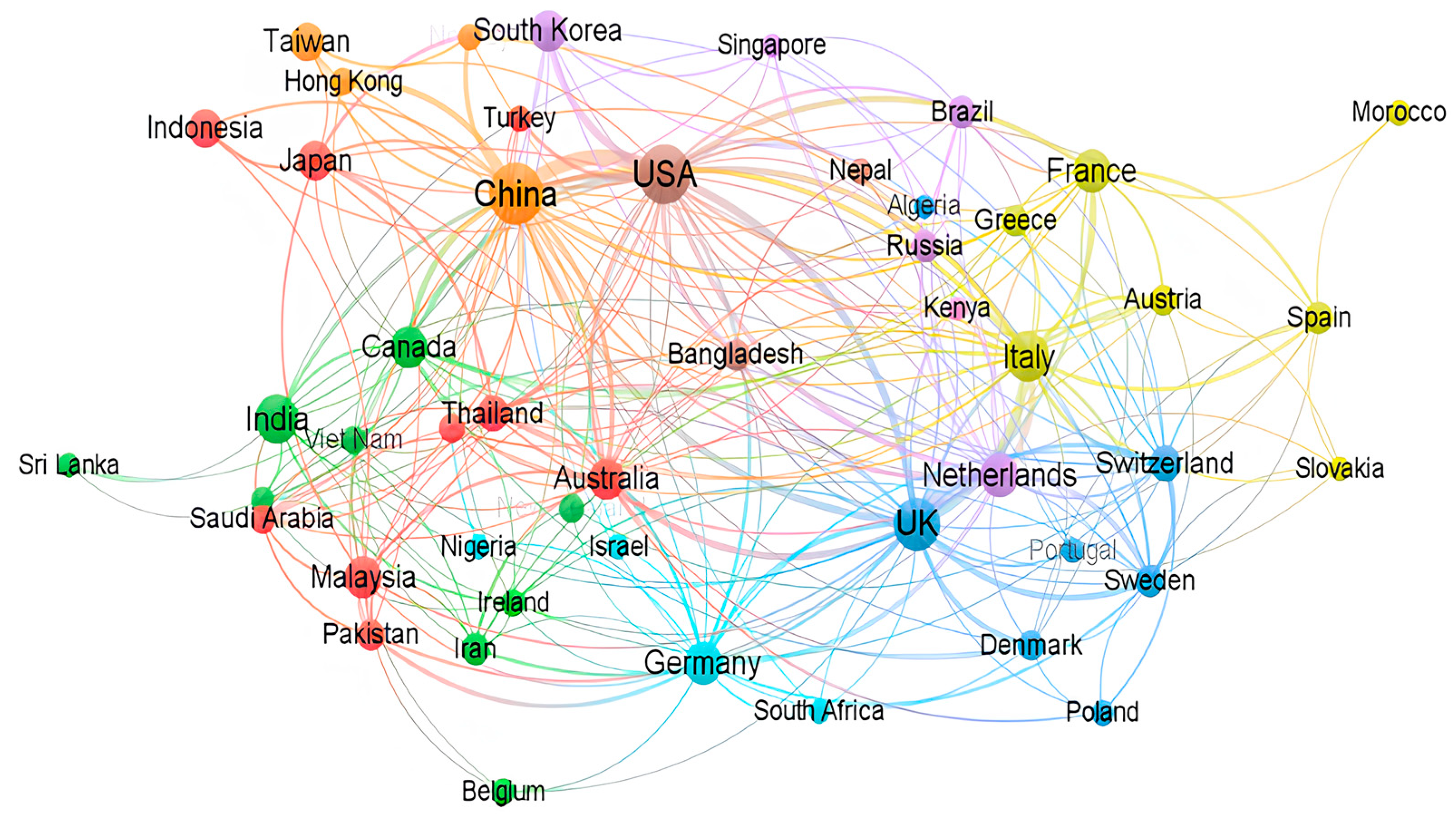


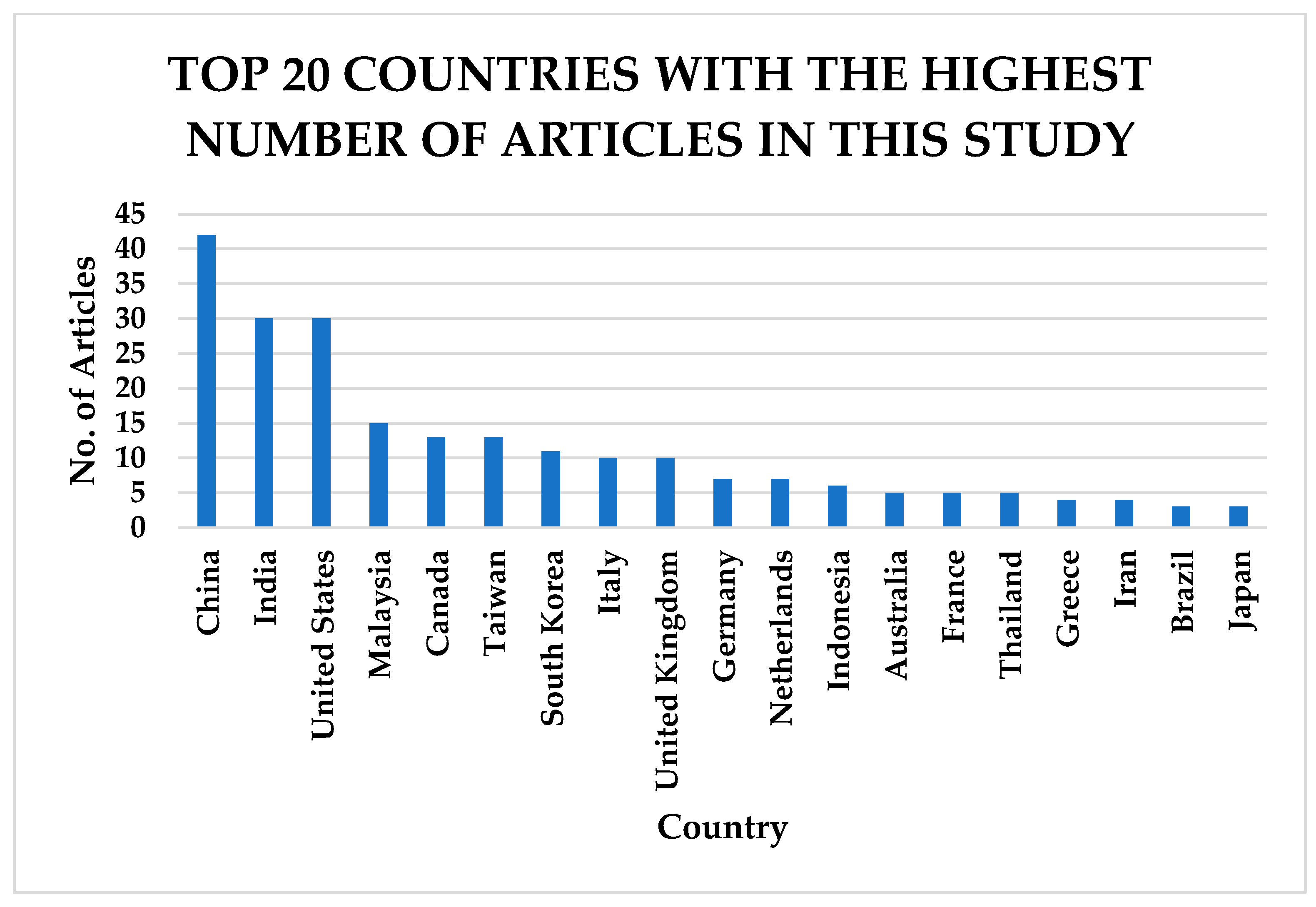
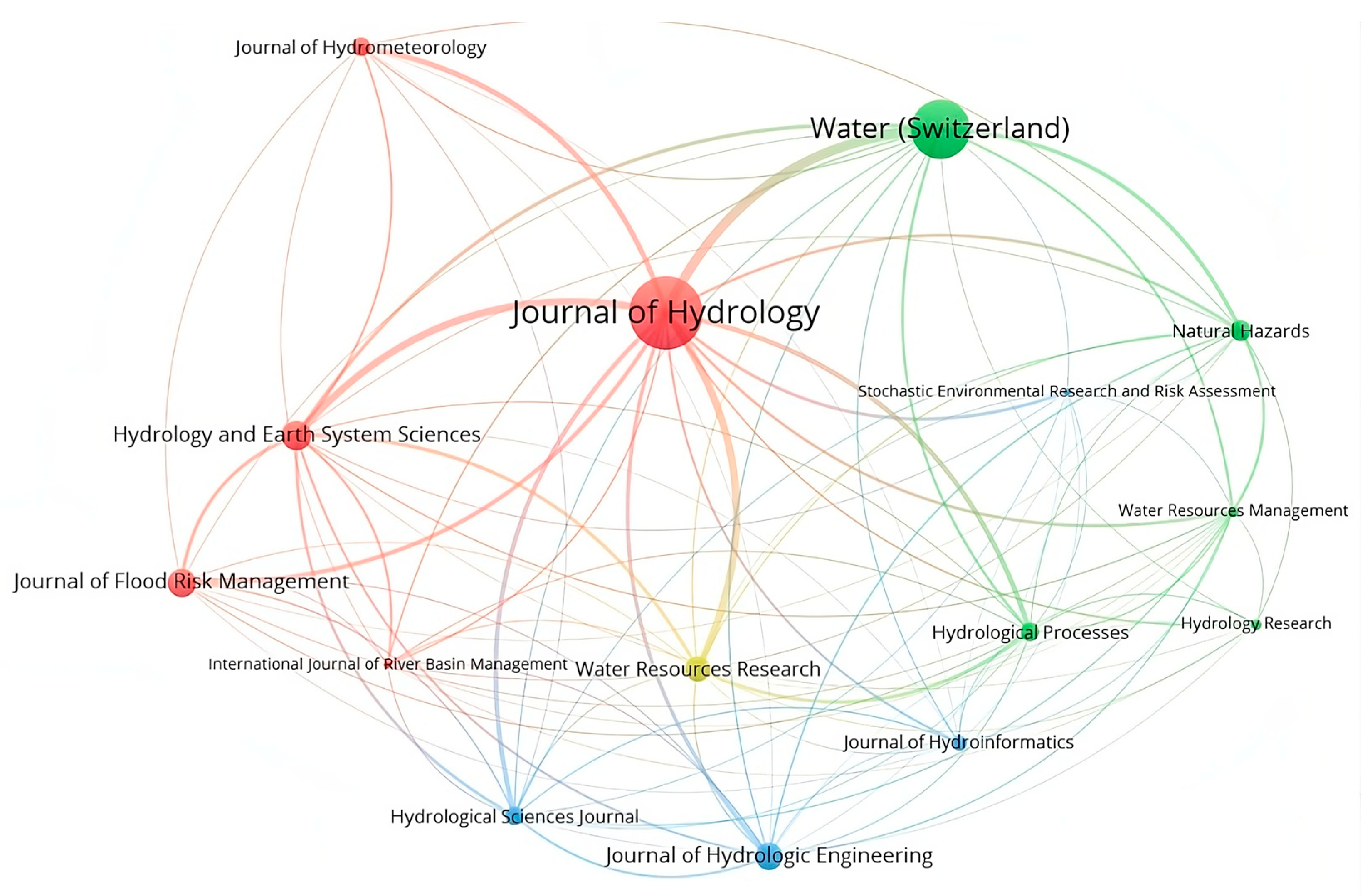

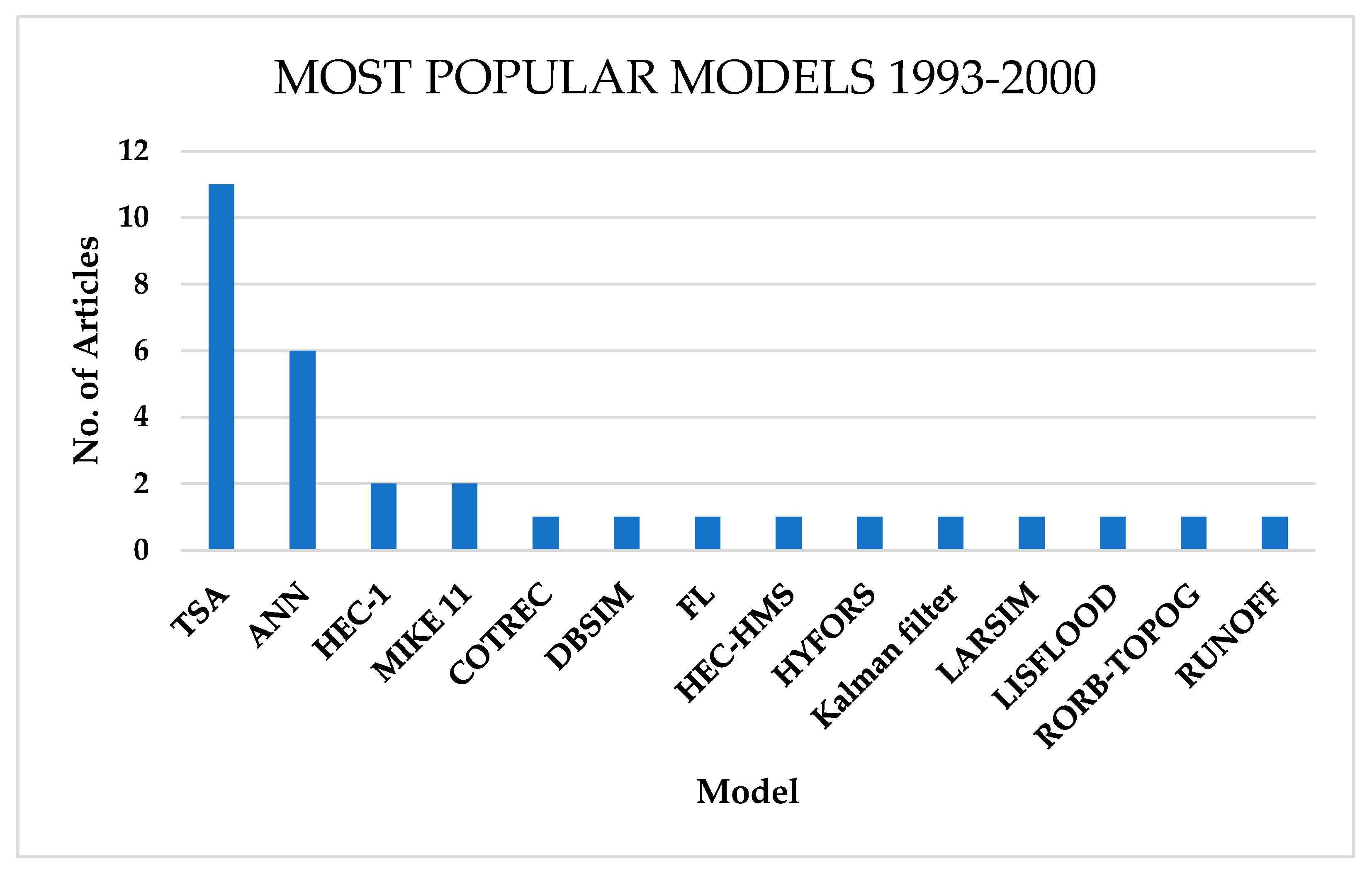

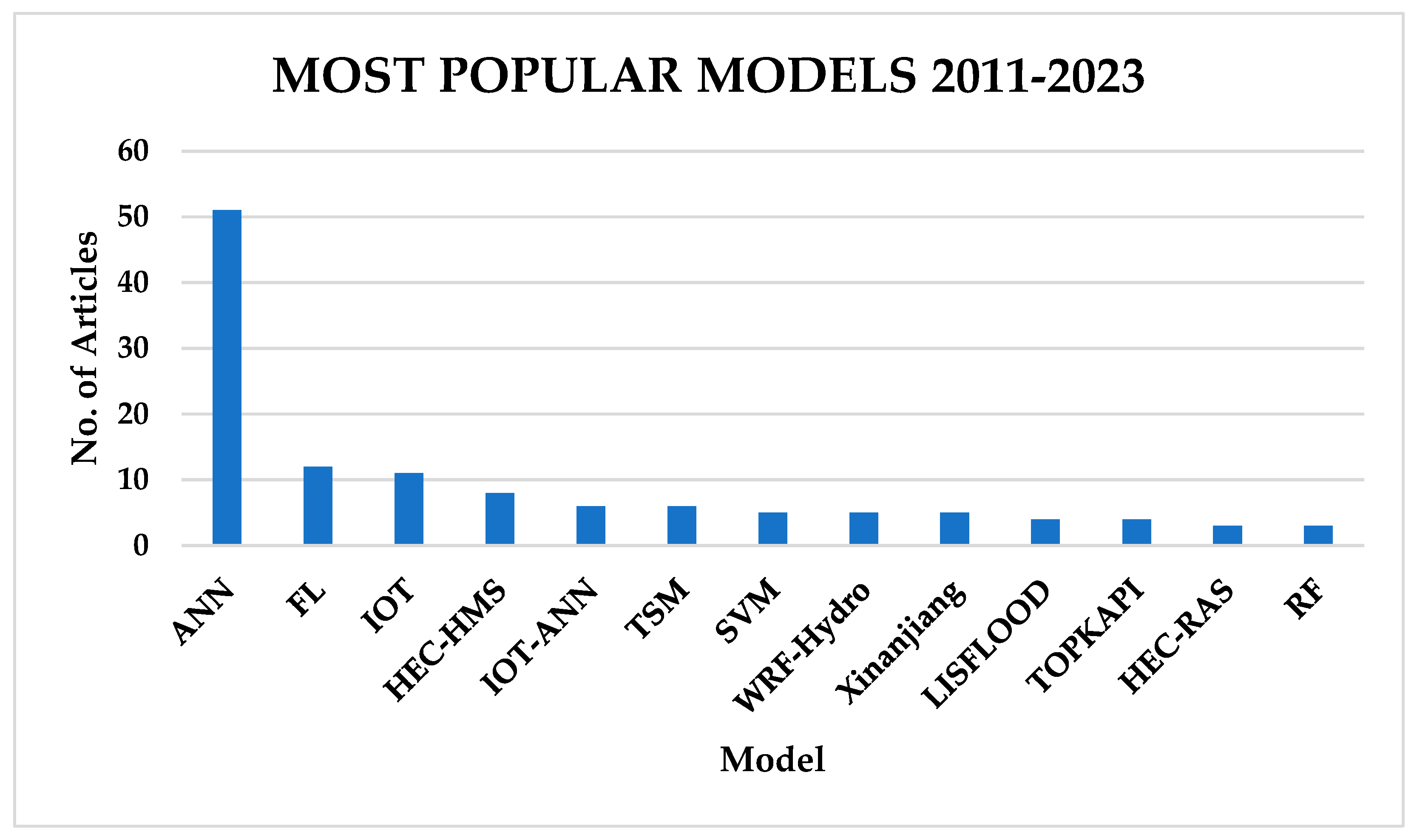

Disclaimer/Publisher’s Note: The statements, opinions and data contained in all publications are solely those of the individual author(s) and contributor(s) and not of MDPI and/or the editor(s). MDPI and/or the editor(s) disclaim responsibility for any injury to people or property resulting from any ideas, methods, instructions or products referred to in the content. |
© 2024 by the authors. Licensee MDPI, Basel, Switzerland. This article is an open access article distributed under the terms and conditions of the Creative Commons Attribution (CC BY) license (https://creativecommons.org/licenses/by/4.0/).
Share and Cite
Byaruhanga, N.; Kibirige, D.; Gokool, S.; Mkhonta, G. Evolution of Flood Prediction and Forecasting Models for Flood Early Warning Systems: A Scoping Review. Water 2024, 16, 1763. https://doi.org/10.3390/w16131763
Byaruhanga N, Kibirige D, Gokool S, Mkhonta G. Evolution of Flood Prediction and Forecasting Models for Flood Early Warning Systems: A Scoping Review. Water. 2024; 16(13):1763. https://doi.org/10.3390/w16131763
Chicago/Turabian StyleByaruhanga, Nicholas, Daniel Kibirige, Shaeden Gokool, and Glen Mkhonta. 2024. "Evolution of Flood Prediction and Forecasting Models for Flood Early Warning Systems: A Scoping Review" Water 16, no. 13: 1763. https://doi.org/10.3390/w16131763





